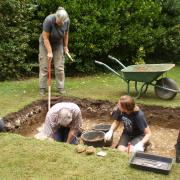Wey Manor Farm, Addlestone
Evaluation by J Robertson and excavation by P Jones of SCAU on the phase 7 and 8 area of this ongoing minerals extraction site. The evaluation produced evidence of a field system of predominantly post-medieval date, as well as a number of ditches of uncertain and probably various dates. Three areas revealed features that contained material indicative of prehistoric and Saxon dates. Further excavation of the phase 7 area uncovered further non-structural Saxon features, as well as a discrete area containing a scatter of struck flints.



